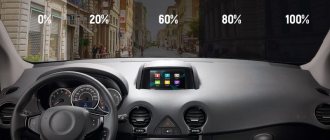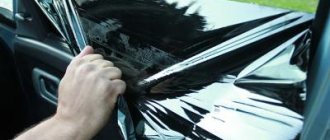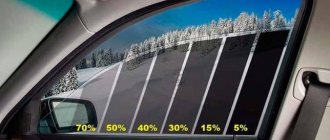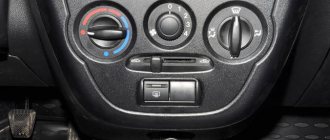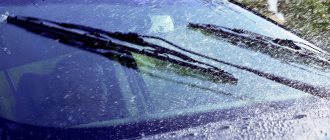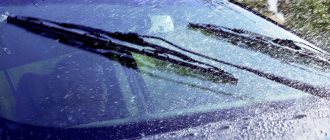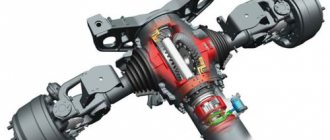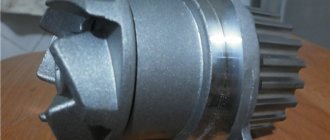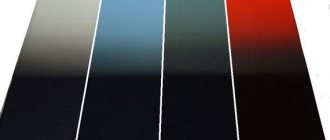In the modern world, there are few drivers who would not like to install films on the glass of their personal cars. Tinting not only makes the car look beautiful, but also protects the interior from ultraviolet radiation. In order to safely drive a car, you will have to comply with a certain law, which states that the transmittance of tinting on the front windows must be at least 70%.
In our article you can get acquainted with tinting in more detail, and compare the descriptions and characteristics of the models presented in the rating below.
What is tinting and why is it needed?
Car window tinting is the application of a special coating to the inside of the glass in the car for the purpose of:
- preventing excessive heating of the interior from sunlight and their negative impact on the internal elements of the body trim;
- increasing glass strength and improving safety in the event of a side collision;
- giving individuality and aesthetic beauty to the car;
- confidentiality, protection of personal space and things inside the car.
Glass tinting can be carried out in several ways: directly at the factory using a special technology, by spraying, or using a special film glued to the inside of the glass.
The most common method of covering glass with tinting film.
It is a transparent polyester base coated with layers of reflective paint and special compounds, depending on the characteristics and the manufacturer. The number of layers is about 9. The film thickness is only 60-380 microns.
Films differ in different light transmittance.
The leading positions among manufacturers of tinting films are occupied by manufacturers from the USA, such as Johnson, Llumar, Solartek.
Car owners who decide to install a tint film often find it difficult to make a choice. Let's try to figure out the details.
You can get a free consultation on choosing a tinting film by calling any number.
Films for glass tinting are divided into premium and economy class. In addition, there are special films - armoring and athermal.
This is interesting: Polishing a car after painting it yourself
What does it consist of?
The main chemical elements are polymers and dyes. The components may vary depending on the intended purpose, type, quality and manufacturer.
The product consists of several layers, the quantity is determined by the type of product. The popular metallized film consists of:
- Elastic polymer base (the basic component of any tint).
- Dyes (set a certain tone and darken).
- Metallized polyester film with metal coating (reflects infrared rays).
- UV absorbers (protect the driver and passengers from their negative effects).
- Adhesive layer (prevents delamination of the structure).
- Contact surface (acrylic resin is used, which is necessary for fastening).
- Anti-abrasive coating (protects against scratches and other types of damage).
Other types may lack certain components. An example is dyed films that lack a metallized element.
What to look for when buying tinting film
To avoid having to remove the recently pasted film already at the first traffic police post, you should take into account the permissible standards. According to GOST 5727-88, the windshield must transmit at least 75 percent of light, and the side front windows - 70 percent.
It is also allowed to glue a dark strip to the windshield, but with a distance from the top edge of no more than 14 cm.
What you should pay primary attention to when choosing high-quality tinting:
- Nice light shade.
- Picture clarity - good films, even with two 5% layers, allow you to see stars in the night sky.
- High-quality material that can withstand long-term use.
- Stable behavior during molding.
Remember that low-quality tint is made from recycled plastic bottles! It’s hard not to notice - the quality of the film is significantly reduced. Try to buy top or first class tint to avoid problems.
Preparing everything you need
Before applying the tint, you need to prepare a clean and dry place to work, as well as a standard set of tools:
- Tinting film that meets the requirements of GOST 5727-88. Light transmittance for the windshield must be at least 75%!, for the front side windows - 70%!, for the rear side and rear - any. Typically, 4 side windows require 1 roll of film filter.
- Liquid soap (without dyes) to fix the film. It is better to use special installation compounds that do not leave streaks, or a 10-20 percent solution of any transparent shampoo.
- Plastic sticker for smoothing tint. Usually it comes complete with a film filter, but if you don’t have one, you can use any elastic plastic, rubber spatula or construction rubber eraser. Also in the store you can find special distillers for removing bubbles (chisler - for hard-to-reach places, slammer - for squeezing the edges, bloomax - for forcing out liquid).
- Scrapers for cleaning glass surfaces. 12 cm products of various shapes are best suited.
- Spray bottle (manual) for applying soap solution.
- Blade or utility knife. The latter is made of mild steel, so it is convenient to cut the film without fear of the glass being scratched.
- Soft rags, clean rags or napkins made of lint-free material.
- Industrial dryer.
If you are tinting your car yourself for the first time, it would be a good idea to purchase special camouflage markers and tapes. With their help you can correct minor errors.
You should also ensure that you have easy access to clean, cold tap water. The room should be free of insects and dust.
If everything is prepared, you can start cutting the film filter.
Tinting in the "economy option" mode
If the owner does not want to overpay for film, but wants to get a good result, it is worth paying attention to the products of the Korean manufacturer Kylon Window Films and the American manufacturer Armolan. The quality of vinyl is not inferior to more expensive analogues, but there is no metallized layer. The cost of pasting starts from 2,500 rubles.
| Order any tint in Moscow |
Total sun protection without loss of visibility
Its advantages over painted and metalized analogues:
- full compliance with GOST;
- possibility of pasting the windshield without consequences;
- free passage of maintenance and traffic police inspections;
- reflection of ultraviolet and infrared rays of the invisible spectrum;
- saving fuel on the operation of the split system;
- does not fade;
- does not distort the perception of primary colors (red, yellow, green, blue, white).
We offer both completely clear vinyl and material with additional shades. The “chameleon” version is in particular demand, which is permitted by Russian legislation and does not lead to troubles on the road.
The best manufacturers of premium tint film
Shadow Guard
The company, originally from South Korea, sells black and athermal films. The PHP CHAORACAL series is highly popular - a unique combination of metal and ceramics. The product can be molded.
Shadow Guard tint film
Advantages:
- service life - 10 years;
- anti-abrasive coating;
- thickness - 38 microns;
- Blocks up to 99% of ultraviolet rays.
Flaws:
- too expensive;
- not the most common product.
SunTek
One of the main competitors of Llumar. On many automotive forums, discussions continue about who is better. Users note that after installation, the temperature in the cabin significantly decreases and the efficiency of climate control increases. The material enhances the strength of glass. The coating prevents scratches and chips and will retain its original appearance for a long time.
SunTek tint film
Advantages:
- does not fade;
- does not obstruct the view
- much thinner than competitors;
- long service life.
Flaws:
- supply problems often arise;
- overcharge;
- difficulty to install.
Circular tinting
Important: this type of car window covering is prohibited.
GOST 5727–88
, and is also fraught with fines from 1,500 to 5,000 rubles. If this doesn't stop you, we recommend the following:
- use film from the same manufacturer (the tone of the same color often differs from one company to another);
- decide in advance on the type of vinyl (metalized or deeply colored);
- adhere to permissible light transmission standards.
Any vinyl presented by our Okleyka-PRO service center is suitable for circular tinting.
We hope we have cleared up some questions. Contact us and we will tint your car!
Related and popular services
- Tinting according to GOST
- Circular tinting
- Headlight tinting
- Athermal tinting
- Tuning
This is interesting: Do-it-yourself exhaust system tuning
Types of tinting coatings
Light-filtering coatings for car windows differ in quality and structure.
Carbon technology
A modern version of darkening film is carbon technology. Graphite coating protects against ultraviolet rays. The material does not fade in the sun, is practical and durable. Carbon blackout sheets are used for tinting glass and car body coverings.
Dyed film
A budget option for tinting is painted. The paint is applied to the polymer structure of the base and does not interfere with the blocking of radio waves. The disadvantage is considered to be fragility: the material is easily subjected to mechanical stress, which shortens the service life of the tint.
Spattered and aluminum coated
Spatter canvases are considered universal: they are suitable for cars or indoor windows. During manufacturing, the pure film is combined with metal alloys into a homogeneous mass by positively charged gas ions. The canvas has a mirror effect and is used for application to rear windows. Manufacturers provide a lifetime warranty on spatter coating.
Film with fade-out
In this type of protective coating, metallic coating grows from bottom to top. Maximum protection against ultraviolet rays is concentrated in the upper part of the window. The progressive darkening effect provides optimal protection during the hottest part of the day - at midday.
Thermal coating with UV protection
This innovative film reduces glare, reducing strain on the driver's eyes. Although car glass looks transparent on the outside, it protects from the sun's rays entering the car's interior. Athermal coating is recommended to be applied to front windows.
Protective covering
Anti-vandal quick-release protective films protect from ultraviolet radiation and also have a strengthening effect. When hit, auto glass does not shatter, but remains on a protective base.
Types of films
Car window tinting can be done using the following types of films:
- athermal. A special feature of the model is the absolute invisibility of the layer; it is used exclusively as a protective coating. The benefits of applying athermal film come down to protection from the scorching rays of the sun, preserving the appearance for a long time without affecting it in any way, which is appreciated by lovers of classic designs. Traffic police officers will not be able to make claims against the glass. The product is supplied in rolls with a multi-layer and fairly dense coating, which effectively protects against damage;
- with metal particles - it is called mirror. This type of glass tinting will create a mirror-like appearance when viewed from the outside. The range includes options with varying degrees of mirroring and color saturation. There are not only silver films, you can choose black or dark colors. The disadvantage is possible problems with the traffic police;
- painted. Helps to add or complement the style of the car. With its help you can create a holistic appearance and perception of the design. There are many degrees of darkening; when choosing, you need to study the assortment in the city stores. It can be pasted over manually;
- art or with a picture. This tint is always translucent, and some image is printed on it. Perfect for self-expression at low financial cost. Most often, drawings are placed on the doors, but there are also options for the rear window. Almost never sticks to the front;
- perforated. This type of toning is actively used for advertising media. It is often applied to most of the surface of the car. Saturation, color density, hue, pattern and all other parameters are selected individually. Most often it has to be ordered. A distinctive feature is the presence of small holes; they provide sufficient light conductivity;
- silicone. Can be applied and removed at will. Electrostatic effect is used for fastening; no glue is needed;
- color tinting. The only difference is the variety of colors.
In each film, the manufacturer strives to achieve the same technical characteristics: protecting the interior from ultraviolet radiation and preventing glass destruction from mechanical damage. If desired, you can easily dismantle the covering and install another one. The exception is factory tint, which cannot be removed.
Athermal tinting
Factory tint
The well-known desire to darken windows has been taken into account by car manufacturers; some of them immediately install darkened windows. The car will be tinted at the factory upon a separate request; the entire line is not subject to tinting due to various wishes of customers.
The main disadvantage is the non-removable type of construction, but the advantage is that it cannot be scratched, that is, it is an eternal tint that is not subject to fading, wiping, etc. It is impossible to create such a coating with your own hands.
The technology is characterized by the application of a special finely dispersed paint that is resistant to various negative influences. No film is used. Similar work can be performed in a service station, but the quality will still be somewhat lower, since homemade technologies are unable to completely repeat this process.
Electronic tinting
A new direction in tinting is smart, the coating has an interactive reflection. If desired, the driver can change the saturation and even the color of the material. It is based on the principle of the influence of electric current on a special substance, the particles of which, changing their orientation, change the degree of transparency of the inner layer of the film. A small remote control is used for control; it is included in the kit.
Electronic car window tinting
The advantages are obvious:
- You can express yourself in new ways every day;
- there is no need to re-stick the film to change color;
- When approaching a traffic police post, it is easy to increase the transparency of the glass to avoid a fine, and the rest of the time, increase the level of darkness.
The main disadvantage is the high price. The cost of smart glass ranges from $5 to $10 thousand.
Armoring (strengthening) films
The main purpose of this type of film is protection against splinters in the event of mechanical damage to the glass.
The main purpose of this type of film is protection against splinters in the event of mechanical damage to the glass, as well as the ability to prevent penetration into the interior. Armor films have different protection classes. The higher it is, the longer the film will withstand external mechanical influence. There are three protection classes. The maximum class A3 can withstand a direct hit from a small explosive device.
In addition to their protective properties, reinforcing films have the ability to block UVA and UVB rays and have increased noise insulation properties . They are also available with a darkening effect.
The cost of booking glass can be found in our price list
Characteristics of removable tinting
Removable tinting is a film that has a static effect of adhering to car glass. In terms of external characteristics, it differs slightly from ordinary film. The only noticeable difference is that after gluing it there is a clouding effect, which disappears as a result of shrinkage.
The main characteristics of removable auto-tinting include increased resistance to low temperatures and mechanical stress. During long-term use, the film is not damaged or deformed. Removable tinting perfectly protects the interior from ultraviolet radiation and does not interfere with normal illumination.
Plastic removable tint option
A distinctive feature of removable film compared to conventional film is the possibility of reusable use without loss of proper appearance and effectiveness. Regardless of the number of removals and re-installations with your own hands, it will protect the interior of the car and hold firmly to the windows.
Features of darkening film
In addition to the positive aspects, the material has negative ones: deterioration of visibility at night, fines from the traffic police for excessive darkening.
Features of the darkening material include:
- the ability to trap or repel ultraviolet rays;
- different percentage of retroreflection from the surface of tinted car glass;
- the amount of solar rays absorbed.
The main feature of the light filter is the light transmission parameter: it must comply with GOST and not exceed 70% for the front and side windows.
Light transmittance of tinting according to GOST
Modern GOST, which regulates the permissible level of tinting of car windows in 2021, divides all glass into 2 large categories. The first category includes glass that provides forward visibility, and the second category includes rear visibility (from the driver's side of the car).
The tint level is calculated as a percentage
. Percentages indicate exactly how much sunlight passes through car windows tinted with a special dark film. For the first category (front view glass), the following maximum tint values apply:
- the windshield is allowed to be tinted with a film that transmits at least 75% of sunlight;
- front side windows can be tinted with a film that transmits at least 70% of sunlight;
- the rear window of the car, as well as the rear side windows, can be tinted with any film except mirror (however, the car must be equipped with rear-view side windows);
- a special rule is established for the windshield; its upper part can be tinted with a strip of any light transmittance, but its width cannot exceed 140 mm (used to protect the driver’s eyes from direct sunlight).
Modern GOST allows without restrictions to use curtains or blinds instead of tinting, but only for the rear window and rear side windows (if the car is equipped with side rearview mirrors).
On buses, curtains are allowed on all side windows, as well as on the rear window.
Why is tinting cheaper in other services?
The cost of installing tinting and special films depends on many factors. Autostudio works only with original films from leading manufacturers, while many unscrupulous installers use counterfeit and low-quality films.
To obtain an ideal result when installing films, it is necessary to observe special conditions in the room (humidity, absence of dust), and have the necessary equipment.
The experience and qualifications of the craftsmen also directly affect the quality of work. We comply with warranty obligations . For premium films it is 3 years . If problems are found, the glass will be completely re-glued at our expense.
Examples of work on applying tinting films
You can install the film that is right for you in any branch of Autostudio Moscow and St. Petersburg that is convenient for you. All you have to do is make an appointment by phone.
Applying film for tinting on car side windows
Wet the surface of the side glass and use a scraper to clean its lower part. Then lower the glass a few centimeters, wet it and also clean the rest of the surface using a scraper.
Clean the surface with the blade consistently and make sure that there are no uncleaned areas.
Next, wash the glass with a hard sponge and wipe dry using a rubber pad. Wipe the edges of the glass with a napkin. Moisten and wipe the glass again with a rubber pad.
- Before applying the tinting film, wet the glass generously.
- Then it is necessary to remove two-thirds of the liner protecting the adhesive layer from the workpiece and moisten the adhesive surface. It is convenient to carry out this operation on the rear window of the car by placing the pattern with the adhesive layer facing outwards.
- It is better to cut off the excess liner removed from the workpiece before applying the tint film.
Wet your fingers. Your fingertips must be clean, since in the process of tinting the glass you will need to touch the adhesive layer of the film.
Carefully take the workpiece and place it on the prepared glass surface.
Try to ensure that the adhesive layer only touches the surface of the glass and does not touch the seals or other surfaces.
Align the tint film along the top edge. Make sure that there are no gaps or gaps anywhere, and begin to carefully squeeze the solution out from under it.
Follow a few simple rules:
- Hold the pattern with your hand, since when you initially squeeze out the liquid, the workpiece will slide along the glass.
- Squeeze water from the center to the edges.
- Use rubber and then hard forcing. Using hard distillation, expel the liquid in the same directions - from the middle to the edges.
- Then, using a forcing tool and a hair dryer, fix the film at the top edge of the glass.
- After this, use a knife to remove the excess tinting film protruding onto the upper edge of the glass - this technology allows you to avoid leaving gaps along the upper edge.
Raise the glass. Bend down the bottom part of the pattern protected by the liner and generously moisten the glass with the solution. Remove the liner completely.
Do this extremely carefully and make sure that the film without a liner does not touch anything other than the glass with its adhesive layer!
Carefully tuck the tint film under the glass seal
Squeeze out the horizontal inner seal using a force and, when inserting the film for tinting, make sure that it does not break - this operation also requires certain skills, so be especially careful (pay attention to how the master will carry out this operation in the video tutorial below)
- Squeeze the solution out from under the film using hard forcing: squeeze out the water in successive movements from top to bottom and from the middle to the edges.
- Finally remove any remaining moisture using a distiller wrapped in a napkin and a hairdryer.
- Make sure that no water bubbles remain under the film during the tinting process.
The technology for cleaning and sticking small fixed glasses will be identical.
Selection of tinting material
How to choose a tint for a car that matches the color, type, and light transmittance of the darkening coating depends on following the basic rules.
Prohibited types of film
Prohibited materials include mirror materials that are used only on rear windows. Their installation on the windshield or front door windows is prohibited by law. Too dark filters, which impair visibility in the evening, are prohibited.
Coating color
The tint coating differs in shades and can be:
- blue;
- brown;
- green;
- red;
- black.
Tinting is available in matte, metallic or mirror finish. Often, owners choose a filter to match the color of their car.
Light transmittance
The main indicator when choosing a material remains the percentage of light transmission - the glass darkening standards. Windshield and front side windows must certainly comply with GOST: this will protect road users and also eliminate the fine imposed by the traffic police.
The rear windows are tinted upon request. If the driver wants the interior not to be visible, he must install a canvas with 5-10% light transmission.
In other cases, a 35% transparency coating is used.
Other characteristics
Many owners select a tinting canvas, focusing on the manufacturer who is responsible for the quality and durability of the material. You can choose an inexpensive coating with good properties. When choosing, it is important to consult with motorists who have used this material, or look at reviews on forums.
The cheapest tint will last no more than 2 years - it’s not worth buying.
As an example, we briefly present the classification of LLumar films
- AT series are films resistant to mechanical damage of varying degrees of toning.
- ATR series - a feature of this series is the presence of an additional metallized layer.
- ATN series are films with a laminated multilayer construction. Their structure has a name: color-metal-color.
- PP series – tinted films. And so on.
An important factor when choosing a film for tinting car windows is their cost. It's time for us to get used to the fact that good things don't come cheap. Not because it's an advertising slogan. But because to produce high-quality tinting film you need high-quality equipment and raw materials.
Choose your film sedately and thoughtfully. We are confident that then you will choose the best film. Don’t be tempted by very lucrative offers, otherwise in a year you will very much want to find a seller of the film that has already peeled off the windows of your car.
Window tinting refers to various methods of darkening car windows, which limit the view of the interior from the outside and prevent sunlight from entering the car.
There are certain standards for acceptable tinting of car windows, violation of which will sooner or later lead to the payment of administrative and vehicle operating rules. The latest changes to the law in the field of tinting side and windshields on cars apply to January 1, 2021. How much tinting is officially allowed for front and rear windows?
Permissible percentages
In addition to its beautiful appearance, tinting also has a practical component. In the event of an accident or a stone hitting the glass, it will not shatter into small pieces with the risk of injuring passengers. The film (but not every one) will protect from ultraviolet radiation and direct sunlight. Some films will help reduce the temperature in the cabin by several degrees, and keep you warm in cold weather.
The degree of shading of the tint is measured as a percentage. The lower the number, the darker the film. With a light transmission of 50-100%, it is almost impossible to determine the presence of tint by eye. According to current legislation, you have the right to use 75% of the film or lighter for the windshield, and 70% or more for the front side windows (no one can see it). Therefore, “by law” it makes sense to glue only a transparent athermal film to the front windows, which will at least protect from the sun and heat. It is allowed to place a dark stripe at the top of the windshield, but such tinting is allowed to be placed at a height of no wider than 14 cm.
Tinting films with a low percentage of light transmission not only protect the car from prying eyes, but also significantly impair visibility at night
Rear windows can be tinted at your discretion, only mirror films are not allowed. 5, 10 and 15 percent darkness will not allow you to see anything in the car. At 20-35%, silhouettes can already be distinguished. Please note that it will also be worse to see from the inside (especially at night and with cheap films).
These standards are regulated by GOST 5727-88 and certain conditions are required to verify compliance:
- air temperature from -10 to +35 degrees;
- humidity not higher than 80%;
- taumeter (measuring device) with documents and seal.
Consider not only the beauty of appearance, but also compliance with the current norms of the Code of Administrative Offenses
The penalty is 500 rubles until a new law is adopted. Rooms will not be removed for such a violation. Tricks with removable tinting do not exempt you from responsibility. Therefore, if you are caught with dark windows, it doesn’t matter whether the “shooting” is glued all around or only a couple of front windows are glued, you will still have to pay.
Examples of light transmittance percentages of tinting in the photo: 5, 15, 25, 50, 70 and others
How to choose?
The assortment is so large that it is easy to get lost not only for a beginner, but also for an experienced car enthusiast. The error will cause various kinds of inconvenience when driving. Experts have developed recommendations to avoid such problems. Before purchasing, pay attention to:
- Bandwidth. It characterizes the amount of visible light that tinted glass can transmit. The minimum rate is 5%. A comfortable ride is possible at 15%. The optimal value at which what is happening in the cabin will be practically invisible. With it, driving at night will not cause problems. 35% is practically not used by motorists. This is due to the fact that such a salon is clearly visible from the outside. Choice for people with poor vision. The glue on the windshield is 35% and lower.
- Anti-scratch coating. It is represented by a silicone layer on the product. Without it, scratches will occur during gluing and smoothing with a spatula. When the glass is lowered, white scratches form because grains of sand get stuck between the tint and the felt. This is prevented by a silicone coating. Manufacturers producing products in the premium segment create such a high-quality silicone coating that even touching a cigarette butt cannot cause harm. On the packaging, the silicone layer is indicated by the SRC marking.
- How quickly does it burn out? High-quality ordinary film can last for 2 - 3 years. From 3 to 5 metallized and American (permanent dyes) are used. Spatter and ceramic ones last for 7 years.
- Molding. The need for molding is encountered when gluing glass that bends in two planes into a single piece. To do this, use an industrial hair dryer in the second operating mode (temperature 600 - 700 degrees). A quality product includes lavsan that stretches when heated. Polyethylene is not capable of this.
- Clarity of view through film. On low-quality products, the dye is distributed unevenly and this is clearly visible by the ripples on the surface. They cause fatigue and decreased concentration.
Types and features of film coating
Regardless of the type of film, the high-quality properties and required qualities can be noted to be the same. Tinting makes it possible to protect your car from the harmful rays of the sun, which often causes the interior of most drivers to burn out. In addition, tinting can protect the glass from various other defects. There are quite a few different types of film, but we will highlight four popular types among car enthusiasts:
- Athermal - this type of film leaves the glass completely transparent, but protects the glass from various damages.
- Mirror – the difference between this film and the usual one is only in the mirror coating.
- Removable - glued to the glass with glue, using a static effect.
- Colored - one of the differences between such film and regular film is just its color.
DIY window tinting instructions
You can apply the tint sheet yourself without the help of a mechanic:
- Wash the car thoroughly. Glasses should be especially well cleaned.
- Choose a place to carry out work. The best option would be a garage, because... On the street, dust can get under the film, which will ruin the material. In the garage, you need to do a wet cleaning in advance, close the doors and windows tightly.
- Take the tinting material out of the packaging, moisten the car glass with soapy water, apply the film to it, cut the blank to size, taking into account that the bottom of the prepared template will go under the window seal.
- Remove the seal, thoroughly clean the surface from dirt and dust and reapply the soap solution.
- Remove the protective layer from the tint and apply it to the glass.
- Using a spatula, carefully smooth out any uneven surfaces.
If after leveling the small bubbles do not disappear, it’s okay: just leave the car for a day with the windows closed, and the tinting material will dry completely.
How to apply tint yourself
The tint coating should only be applied to clean glass. If work is carried out indoors, there should be no dust in it. Polluted air is one of the reasons for the appearance of bubbles. If you perform the steps without removing the glass, then the interior should also be clean.
If, due to complexity, you want to refuse a job, you always have the opportunity to contact the service. In addition to the fact that the window should be smooth, you should remove everything unnecessary from it, for example, the antenna.
What you will need
Before work, you need to prepare tools and material. Among everything you may need, consumables should not be neglected.
- Tinting film. The quantity should be enough for the side windows, as well as the front and rear glass.
- Rubber spatula and plastic scraper.
- Shampoo.
- Spray.
- Stationery knife with a retractable blade.
- Lint-free cloth, dry.
- Clean and warm water.
- Home or technical hair dryer.
Also, before work, the material must be prepared. Cutting out the film is not a difficult task, and involves cutting out pieces that will be 2-4 centimeters larger than the size of the surface to be tinted.
Car preparation
The next stage is preparing the machine itself. For quality work, be sure to wash the car and workplace
Even grains of sand can cause defects during operation, so attention to detail is worth paying attention to. Apply the film only to a clean surface and in clean conditions.
Therefore, car windows must first be washed on both sides using a special cleaning solution.
Even after washing, when wiping the car with a soft cloth, you must make sure that no lint remains on it - you cannot glue the tint material without bringing the coating to perfect cleanliness. Work should begin with the side windows.
Only after pasting them over can you gain experience and begin working on the rear and front glass. Then the process can go in two directions - removing the glass or not removing it. The most convenient way is to remove the glass; the effect of this is much higher, although it forces you to tinker, doing extra work.
We make the film ourselves
The advantages of tint film have already been described in detail, but the question remains: how and what is it made from? The production of car tinting is based on polyester material. The base for production must be of high quality, and very few companies produce such polyester. The classic film consists of several balls. The thickness of each is 20 microns. The manufacturing technique is quite complex; the layers are rolled at a certain temperature.
It is very important that when used, the film does not distort the appearance of things and the interior. To achieve this, much attention is paid to the same physical characteristics of the base in its different sections.
This property allows the film to be glued to any type of glass.
You can also tint your car at home. However, it is not possible to create a high-quality product that will meet modern norms, standards and operational requirements. Tinting film is made using temperature and chemical composition in a factory; recreating the process at home can be an impossible task.
Pasting technique
The methods for gluing the coating to the side, front and rear glass are not much different. Experts advise starting with the sides. Only then, having gained experience, can you begin to apply coating to the rear and windshield.
Before starting the procedures, the side windows are washed with water and a scraper, and then wiped with a rubber pad. The edges are wiped with a napkin, and hands are washed with soap before the second part of the work. The glass is moistened with soapy water, and the protective coating is removed from the pattern. The adhesive part is wetted with the solution, as are the fingers. The film is carefully applied to the glass, the absence of gaps is checked and how smoothly the applied material fits. Excess water is removed. Drying too hard can scratch the coating. Water is removed with progressive movements from the center to the edges.
The upper part of the film coating is fixed a little later. The remaining part is also moistened with soap solution. The film is tucked under the lower seal; kinks should not be allowed. The remaining liquid is removed from under the film with a hairdryer and distillation. There should be no water bubbles after finishing work. They can be removed almost immediately after applying the tint by walking over the glass with a rag or soft cloth.
Comparison table of characteristics
Based on the rating compiled above, we have prepared for you a comparative table of characteristics of the presented models of car tint films, with the help of which you can compare the characteristics of a particular film, which can later help you in choosing a tint film.
| Models | A country | Light transmittance (%) | Price (rubles) |
| Llumar | USA | 50 | 20 – 900 |
| Armolan | USA | 5 | 400 – 700 |
| SUN GARD | USA | 35 | 450 – 1 200 |
| ASWF | USA | 5 | 400 – 900 |
| SunTek | USA | 10 | 50 – 900 |
| SunControl | USA | 35 | 700 – 2 000 |
| Global | England | 50 | 350 – 15 000 |
Nuances of choice: how to cover the rear and front windows of a car
Having decided on your attitude to GOST and its standards, you can proceed directly to choosing an option for yourself. Please note that the glass itself does not transmit 100% of the light (usually 90-95%). Before installation, it is advisable to take a small piece of material and check the total light penetration rate with the device.
Let's start with the "state employees". If finances are very limited, then you can even look towards Chinese film. Just don’t glue it yourself - you’ll suffer, use the services of pasters (you can then demand that the defects be eliminated from them). If you are consciously prepared for a short service life and gradual loss of color, this may be your option.
Dyed films from “famous” manufacturers from the previous section are distinguished by better strength and ease of gluing than Chinese ones. You can choose a more expensive film and edit it yourself. For the same money you will get a better quality car product.
The next “level” includes all types of metallized films: color, gradient or simply black. In addition to changing the appearance, the “load” includes protection from ultraviolet rays and good wear resistance (you can count on 5–6 years). True, you will have to pay extra for these properties. Good craftsmen can apply almost any design to color film (at the same level as airbrushing). If you are willing to pay an extra +30% for a higher quality product, take a tint film made using spatter technology.
Don't forget that the rear windows of a car are still intended for something. Or at least get a panoramic rearview mirror
Athermal film is suitable for practitioners who decide to comply with the law. Transparency allows you to completely cover the windshield and front windows. A high-quality “athermal” retains up to 90% of heat from the sun’s rays. Many people note that after installation they began to turn on the air conditioning much less often. This is achieved through multi-layering (up to 20 layers, depending on the manufacturer). Each layer blocks a specific narrow spectrum of ultraviolet and infrared rays. Naturally, such complex technology leads to higher costs. This is an option for those who are willing to pay for their comfort (windshield from 3,000 rubles). “Chameleon” performs the same functions, only with a beautiful shimmer, so it costs twice as much.
Color and gradient films are suitable for tuning lovers. Usually in such cases the "invisible" properties do not have much meaning. The main thing is to choose the right color.
When choosing a film for tinting, the main criterion is price. If there is no certain amount, then the choice is limited. But for every thousand you put on top, you get additional properties. Decide how important they are to you, and the choice will become clear. If you don’t glue it yourself, then take an interest in the finished work or find reviews on the Internet about how they can ruin the best film.
What are they?
- Painted. A budget option. The composition includes pigments that give the required color. Its quantity has a direct effect on light transmittance. They do not glare, nothing interferes with the proper operation of radio devices. But it quickly deteriorates and is practically not resistant to negative environmental influences. Now they are practically not used.
- Metallized. The main feature is the metal layer applied on top of the painted one. In most cases it is aluminum. The layer itself can be internal or external. After pasting, the glass acquires the appropriate shine.
- Spatter. Their properties are similar to metallized ones, the main difference is that the metal was applied by ionization. With its help, it is possible to apply any chemical substance to the polymer layer and, as a result, you can obtain a uniform coating. The manufacturing feature “gave” maximum durability. The belief in quality is so great that some companies producing spatter film offer a lifetime guarantee. Such coatings have an excellent appearance.
- Infinity. The outer side is covered with a metallized layer. This increased the reflective properties to 70%. The acquired mirror shine hindered its distribution and popularization, since such an effect is prohibited by law.
- Combined. They absorbed the qualities of color and metallized films. In them, one tone smoothly transitions into another. The effect is achieved by changing the intensity of spraying of metal particles. The upper dark side will protect from the sun, and the lower light side will maintain good visibility on the road. The product is popular among connoisseurs of visual tuning.
- Athermal (energy saving). Innovative development. With it you can forget about overheating the cabin. Blocks up to 90% of sunlight. A nano ceramic coating with a graphite layer will reliably protect the driver and passengers from the negative effects of ultraviolet rays and maintain impeccable visibility even in adverse weather conditions. It should be understood that it does not darken, in other words, everything that happens in the cabin will be visible to passers-by. The positive side of this point is that the driver will not have any problems with the law. The only thing you should pay attention to is the LA series films, they have a blue tint. It has a negative effect on the eyes. It is preferable to purchase ATR with neutral colors.
- Chameleon. A type of athermal film with a purple tint. After application, the glass shimmers beautifully in the sun. A distinctive feature is the change in the amount of light transmitted depending on the intensity of illumination. In this regard, problems may arise with determining the degree of darkness; the results of measuring tint may vary depending on the degree of illumination of the room.
- Carbon. Elite product. Not very common. Not everyone can afford the purchase. This is due to the manufacturing features. The film is placed in a vacuum and a graphite layer is sprayed onto it. The resulting product has properties similar to metallized ones, but is completely devoid of its weaknesses. Throughout the entire service, it does not lose color and reflects over 50% of infrared rays and does not create glare.
Depending on the intended use, there are:
- Sun protection. Protect the driver from the negative effects of ultraviolet radiation.
- Impact-resistant Armored car windows. When damaged, it becomes covered with a web of cracks and remains in place without crumbling.
- Decorative. Allows you to stand out on the road.
Best lists
You have carried out research on most models of tint films, and have prepared for you the best models in these categories:
- Budget.
- Best quality.
- The best UV protection.
Let's start with the description.
Budget
MTF, despite its budget and the numerous popularity of American films, there was a place for the presented model, because it is designed for a huge range of drivers, producing a huge range of light transmittance.
| Size | 56x6x6 cm |
| Weight | 475 g |
| A country | Russia |
Price: from 150 to 500 rubles.
MTF tint film
Best quality
3M represented by the company is a leader in quality in the domestic market. All this is supported by a multi-layer tinting design that is made on the basis of nanocarbon polyester.
| Dimensions | 64.9x6x6 cm |
| Weight | 550 g |
| Color | black |
Cost: from 150 to 700 rubles.
3M tint film
Best UV protection
JOHNSON is a better tinting for protection against ultraviolet radiation, due to its manufacturing technology - the base is charcoal. Almost does not transmit UV, there is an anti-reflective coating, which eliminates the permissible complication of the driver’s vision.
| UV pass | 1% |
| Heat Reflection | 65% |
| Dimensions | 64x9x6x6 cm |
tint film JOHNSON
The best manufacturers of tint film in the mid-price segment
Global
In a relatively short period of time, the ambitious newcomer was able to win the hearts of motorists and establish himself on the positive side. This was also favorably influenced by the unique characteristics of the products. At the plant, raw materials go through a full cycle, from preparation to packaging of finished products. With Global films, you can forget about interior burnout and the negative effects of ultraviolet rays on the body.
tint film Global
Advantages:
- development involving the latest technological advances;
- long-term operation;
- reduces the degree of heating of the skin by the sun's rays;
- ceramic coating does not affect the operation of radios and other devices;
- many positive reviews on specialized forums.
Flaws:
- practically unknown on the Russian market.
Armolan
Occupies a leading position in the market of tinting films for cars. A distinctive feature that sets it apart from many others is the high requirements for the product. The bar set by Armolan was successfully maintained. The products cover all market segments (from budget to premium). The correct approach to pricing resonated with domestic car enthusiasts.
Armolan tint film
Advantages:
- loyal prices;
- reliable protection against ultraviolet radiation;
- decent thermal insulation performance;
- protection from damage;
- anti-vandal. When hit, the glass does not shatter. There is a shock-absorbing effect.
Flaws:
- visibility at night leaves much to be desired.
3M
Quality and reliability are two pillars that have allowed the American company to take a leading position in the market. They are so confident in their products that they even provide a warranty. The film is based on nano-carbon polyester, without metal impurities. The latter eliminates interference in the operation of electrical equipment. It should be noted that the film has good protection against UV rays.
3M tint film
Advantages:
- guarantee;
- does not act as a source of interference;
- multilayer nano technology.
Flaws:
- difficult to find in stores.
